FIAT ULYSSE 2007 2.G Owners Manual
Manufacturer: FIAT, Model Year: 2007, Model line: ULYSSE, Model: FIAT ULYSSE 2007 2.GPages: 254, PDF Size: 3.42 MB
Page 131 of 254
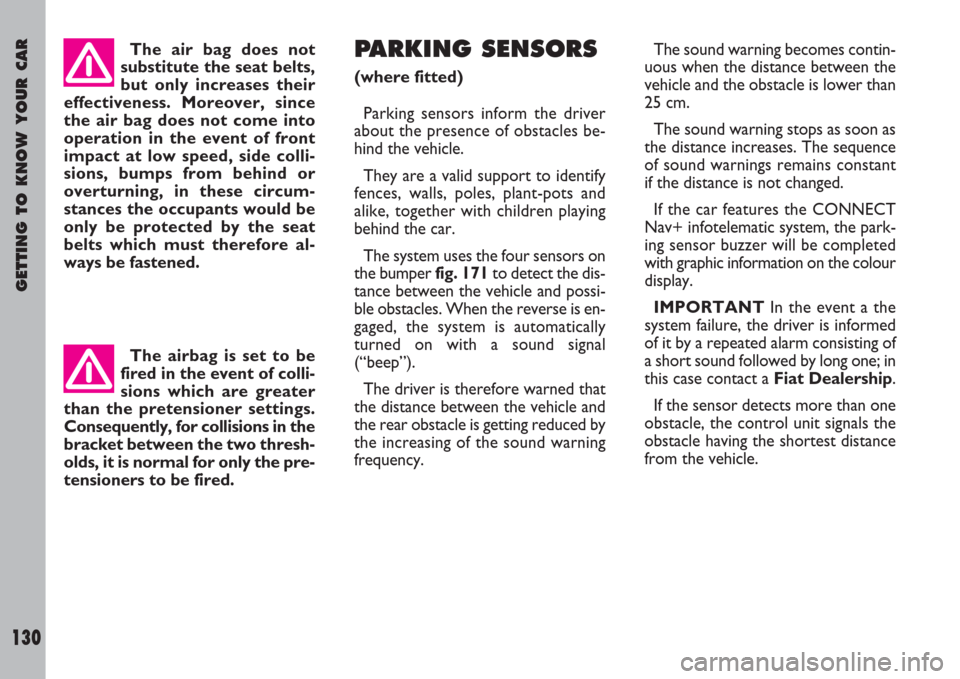
GETTING TO KNOW YOUR CAR
130
PARKING SENSORS
(where fitted)
Parking sensors inform the driver
about the presence of obstacles be-
hind the vehicle.
They are a valid support to identify
fences, walls, poles, plant-pots and
alike, together with children playing
behind the car.
The system uses the four sensors on
the bumper fig. 171to detect the dis-
tance between the vehicle and possi-
ble obstacles. When the reverse is en-
gaged, the system is automatically
turned on with a sound signal
(“beep”).
The driver is therefore warned that
the distance between the vehicle and
the rear obstacle is getting reduced by
the increasing of the sound warning
frequency.The sound warning becomes contin-
uous when the distance between the
vehicle and the obstacle is lower than
25 cm.
The sound warning stops as soon as
the distance increases. The sequence
of sound warnings remains constant
if the distance is not changed.
If the car features the CONNECT
Nav+ infotelematic system, the park-
ing sensor buzzer will be completed
with graphic information on the colour
display.
IMPORTANTIn the event a the
system failure, the driver is informed
of it by a repeated alarm consisting of
a short sound followed by long one; in
this case contact aFiat Dealership.
If the sensor detects more than one
obstacle, the control unit signals the
obstacle having the shortest distance
from the vehicle. The airbag is set to be
fired in the event of colli-
sions which are greater
than the pretensioner settings.
Consequently, for collisions in the
bracket between the two thresh-
olds, it is normal for only the pre-
tensioners to be fired.
The air bag does not
substitute the seat belts,
but only increases their
effectiveness. Moreover, since
the air bag does not come into
operation in the event of front
impact at low speed, side colli-
sions, bumps from behind or
overturning, in these circum-
stances the occupants would be
only be protected by the seat
belts which must therefore al-
ways be fastened.
Page 132 of 254
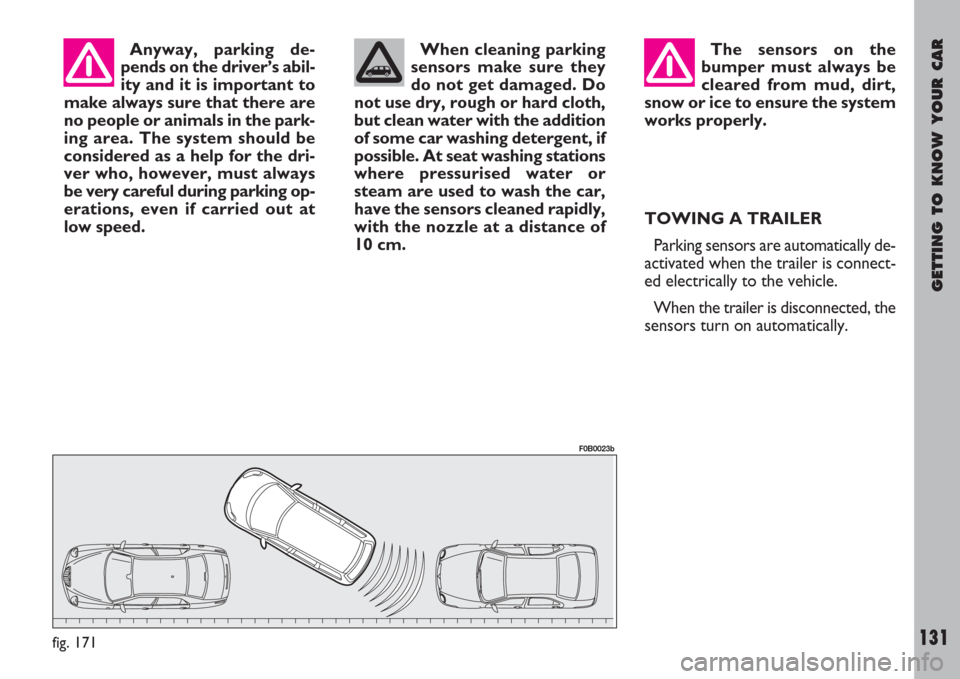
GETTING TO KNOW YOUR CAR
131
When cleaning parking
sensors make sure they
do not get damaged. Do
not use dry, rough or hard cloth,
but clean water with the addition
of some car washing detergent, if
possible. At seat washing stations
where pressurised water or
steam are used to wash the car,
have the sensors cleaned rapidly,
with the nozzle at a distance of
10 cm.TOWING A TRAILER
Parking sensors are automatically de-
activated when the trailer is connect-
ed electrically to the vehicle.
When the trailer is disconnected, the
sensors turn on automatically. Anyway, parking de-
pends on the driver’s abil-
ity and it is important to
make always sure that there are
no people or animals in the park-
ing area. The system should be
considered as a help for the dri-
ver who, however, must always
be very careful during parking op-
erations, even if carried out at
low speed.The sensors on the
bumper must always be
cleared from mud, dirt,
snow or ice to ensure the system
works properly.
fig. 171
F0B0023b
Page 133 of 254
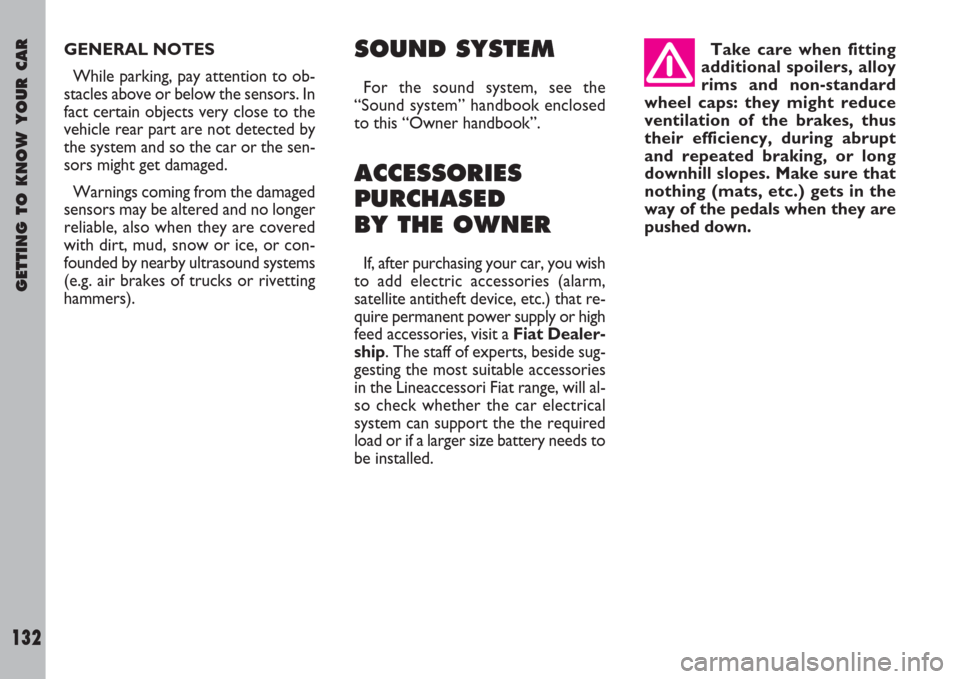
GETTING TO KNOW YOUR CAR
132
GENERAL NOTES
While parking, pay attention to ob-
stacles above or below the sensors. In
fact certain objects very close to the
vehicle rear part are not detected by
the system and so the car or the sen-
sors might get damaged.
Warnings coming from the damaged
sensors may be altered and no longer
reliable, also when they are covered
with dirt, mud, snow or ice, or con-
founded by nearby ultrasound systems
(e.g. air brakes of trucks or rivetting
hammers).SOUND SYSTEM
For the sound system, see the
“Sound system” handbook enclosed
to this “Owner handbook”.
ACCESSORIES
PURCHASED
BY THE OWNER
If, after purchasing your car, you wish
to add electric accessories (alarm,
satellite antitheft device, etc.) that re-
quire permanent power supply or high
feed accessories, visit a Fiat Dealer-
ship. The staff of experts, beside sug-
gesting the most suitable accessories
in the Lineaccessori Fiat range, will al-
so check whether the car electrical
system can support the the required
load or if a larger size battery needs to
be installed.Take care when fitting
additional spoilers, alloy
rims and non-standard
wheel caps: they might reduce
ventilation of the brakes, thus
their efficiency, during abrupt
and repeated braking, or long
downhill slopes. Make sure that
nothing (mats, etc.) gets in the
way of the pedals when they are
pushed down.
Page 134 of 254
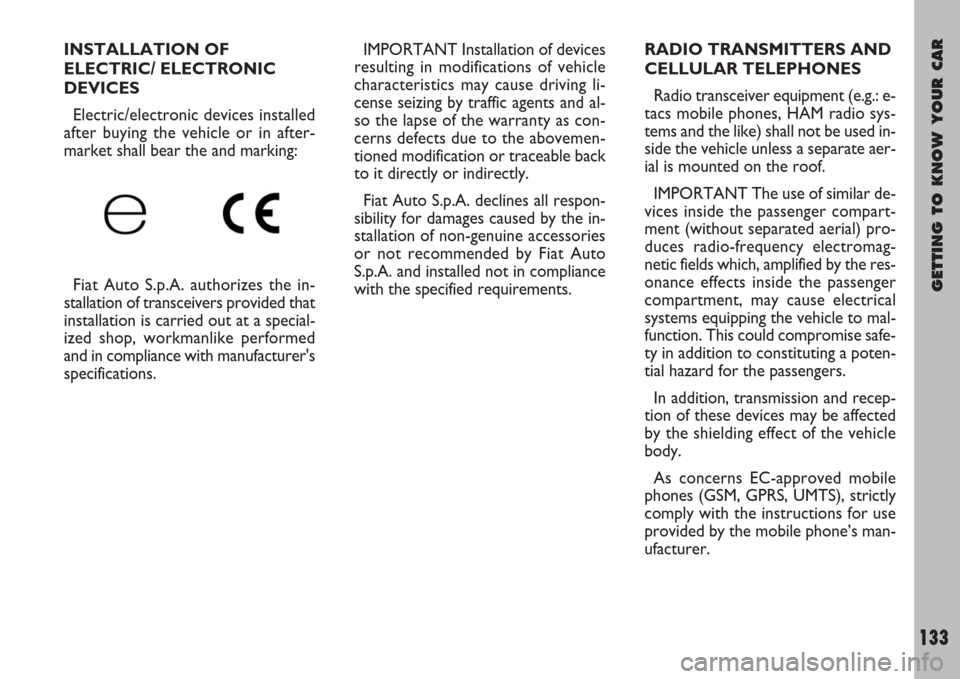
GETTING TO KNOW YOUR CAR
133
INSTALLATION OF
ELECTRIC/ ELECTRONIC
DEVICES
Electric/electronic devices installed
after buying the vehicle or in after-
market shall bear the and marking:
Fiat Auto S.p.A. authorizes the in-
stallation of transceivers provided that
installation is carried out at a special-
ized shop, workmanlike performed
and in compliance with manufacturer's
specifications.IMPORTANT Installation of devices
resulting in modifications of vehicle
characteristics may cause driving li-
cense seizing by traffic agents and al-
so the lapse of the warranty as con-
cerns defects due to the abovemen-
tioned modification or traceable back
to it directly or indirectly.
Fiat Auto S.p.A. declines all respon-
sibility for damages caused by the in-
stallation of non-genuine accessories
or not recommended by Fiat Auto
S.p.A. and installed not in compliance
with the specified requirements.RADIO TRANSMITTERS AND
CELLULAR TELEPHONES
Radio transceiver equipment (e.g.: e-
tacs mobile phones, HAM radio sys-
tems and the like) shall not be used in-
side the vehicle unless a separate aer-
ial is mounted on the roof.
IMPORTANT The use of similar de-
vices inside the passenger compart-
ment (without separated aerial) pro-
duces radio-frequency electromag-
netic fields which, amplified by the res-
onance effects inside the passenger
compartment, may cause electrical
systems equipping the vehicle to mal-
function. This could compromise safe-
ty in addition to constituting a poten-
tial hazard for the passengers.
In addition, transmission and recep-
tion of these devices may be affected
by the shielding effect of the vehicle
body.
As concerns EC-approved mobile
phones (GSM, GPRS, UMTS), strictly
comply with the instructions for use
provided by the mobile phone’s man-
ufacturer.
Page 135 of 254
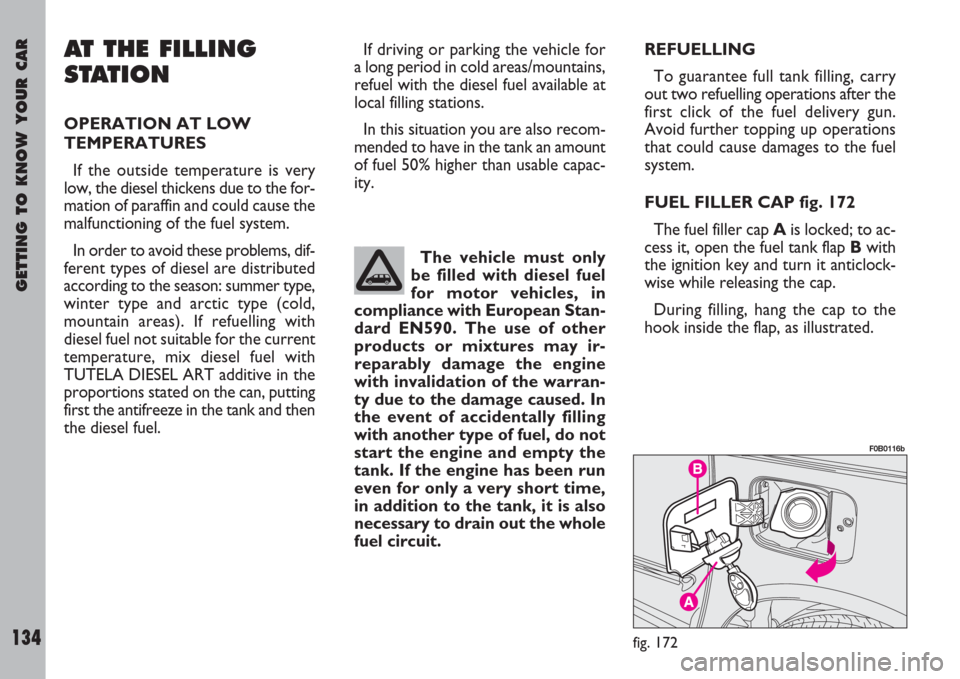
GETTING TO KNOW YOUR CAR
134
REFUELLING
To guarantee full tank filling, carry
out two refuelling operations after the
first click of the fuel delivery gun.
Avoid further topping up operations
that could cause damages to the fuel
system.
FUEL FILLER CAP fig. 172
The fuel filler cap Ais locked; to ac-
cess it, open the fuel tank flap Bwith
the ignition key and turn it anticlock-
wise while releasing the cap.
During filling, hang the cap to the
hook inside the flap, as illustrated.
fig. 172
F0B0116b
The vehicle must only
be filled with diesel fuel
for motor vehicles, in
compliance with European Stan-
dard EN590. The use of other
products or mixtures may ir-
reparably damage the engine
with invalidation of the warran-
ty due to the damage caused. In
the event of accidentally filling
with another type of fuel, do not
start the engine and empty the
tank. If the engine has been run
even for only a very short time,
in addition to the tank, it is also
necessary to drain out the whole
fuel circuit.
If driving or parking the vehicle for
a long period in cold areas/mountains,
refuel with the diesel fuel available at
local filling stations.
In this situation you are also recom-
mended to have in the tank an amount
of fuel 50% higher than usable capac-
ity.AT THE FILLING
STATION
OPERATION AT LOW
TEMPERATURES
If the outside temperature is very
low, the diesel thickens due to the for-
mation of paraffin and could cause the
malfunctioning of the fuel system.
In order to avoid these problems, dif-
ferent types of diesel are distributed
according to the season: summer type,
winter type and arctic type (cold,
mountain areas). If refuelling with
diesel fuel not suitable for the current
temperature, mix diesel fuel with
TUTELA DIESEL ART additive in the
proportions stated on the can, putting
first the antifreeze in the tank and then
the diesel fuel.
Page 136 of 254
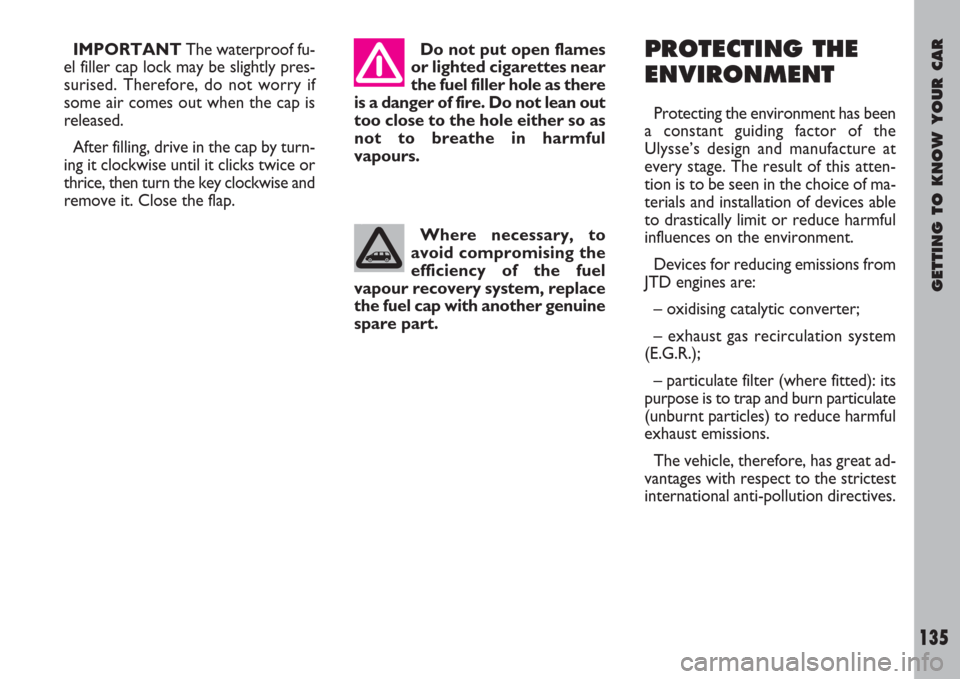
GETTING TO KNOW YOUR CAR
135
PROTECTING THE
ENVIRONMENT
Protecting the environment has been
a constant guiding factor of the
Ulysse’s design and manufacture at
every stage. The result of this atten-
tion is to be seen in the choice of ma-
terials and installation of devices able
to drastically limit or reduce harmful
influences on the environment.
Devices for reducing emissions from
JTD engines are:
– oxidising catalytic converter;
– exhaust gas recirculation system
(E.G.R.);
– particulate filter (where fitted): its
purpose is to trap and burn particulate
(unburnt particles) to reduce harmful
exhaust emissions.
The vehicle, therefore, has great ad-
vantages with respect to the strictest
international anti-pollution directives. Do not put open flames
or lighted cigarettes near
the fuel filler hole as there
is a danger of fire. Do not lean out
too close to the hole either so as
not to breathe in harmful
vapours.
Where necessary, to
avoid compromising the
efficiency of the fuel
vapour recovery system, replace
the fuel cap with another genuine
spare part.
IMPORTANTThe waterproof fu-
el filler cap lock may be slightly pres-
surised. Therefore, do not worry if
some air comes out when the cap is
released.
After filling, drive in the cap by turn-
ing it clockwise until it clicks twice or
thrice, then turn the key clockwise and
remove it. Close the flap.
Page 137 of 254

DRIVING YOUR CAR
136
It is dangerous to let the
engine run in a garage or
other closed area. The
engine consumes oxygen and
gives off dioxide, carbon monox-
ide and other poisonous fumes.
IMPORTANTThe ignition switch
is fitted with a safety device which
obliges the driver to return the key to
Sbefore repeating the starting oper-
ation if the engine does not start im-
mediately.
D D
R R
I I
V V
I I
N N
G G
Y Y
O O
U U
R R
C C
A A
R R
STARTING
THE ENGINE
IMPORTANTThe vehicle is fitted
with an electronic engine locking de-
vice. If the engine cannot be started,
see the “Fiat CODE system” in “Get-
ting to know your car” chapter.
We recommend that
during the initial period
you do not drive to full ve-
hicle performance (e.g.: excessive
acceleration, long journeys at top
speed, hard braking, etc.).When the engine is
switched off never leave
the ignition key at M to
prevent pointless current ab-
sorption from draining the bat-
tery.
Page 138 of 254
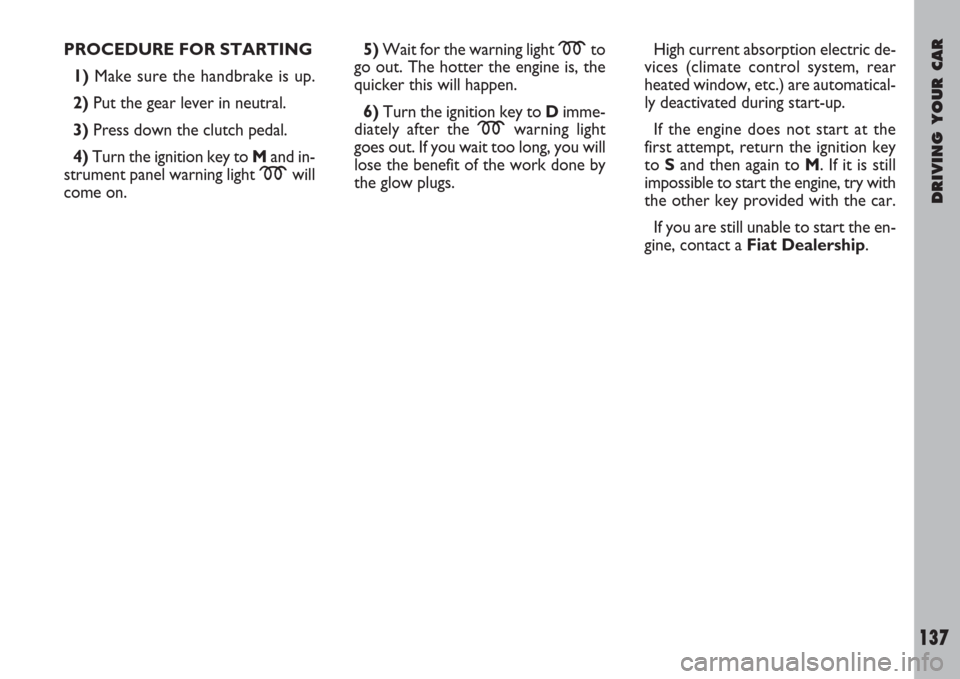
DRIVING YOUR CAR
137
5)Wait for the warning light mto
go out. The hotter the engine is, the
quicker this will happen.
6)Turn the ignition key to Dimme-
diately after the mwarning light
goes out. If you wait too long, you will
lose the benefit of the work done by
the glow plugs. PROCEDURE FOR STARTING
1)Make sure the handbrake is up.
2)Put the gear lever in neutral.
3) Press down the clutch pedal.
4)Turn the ignition key to Mand in-
strument panel warning light mwill
come on.High current absorption electric de-
vices (climate control system, rear
heated window, etc.) are automatical-
ly deactivated during start-up.
If the engine does not start at the
first attempt, return the ignition key
to Sand then again to M. If it is still
impossible to start the engine, try with
the other key provided with the car.
If you are still unable to start the en-
gine, contact a Fiat Dealership.
Page 139 of 254
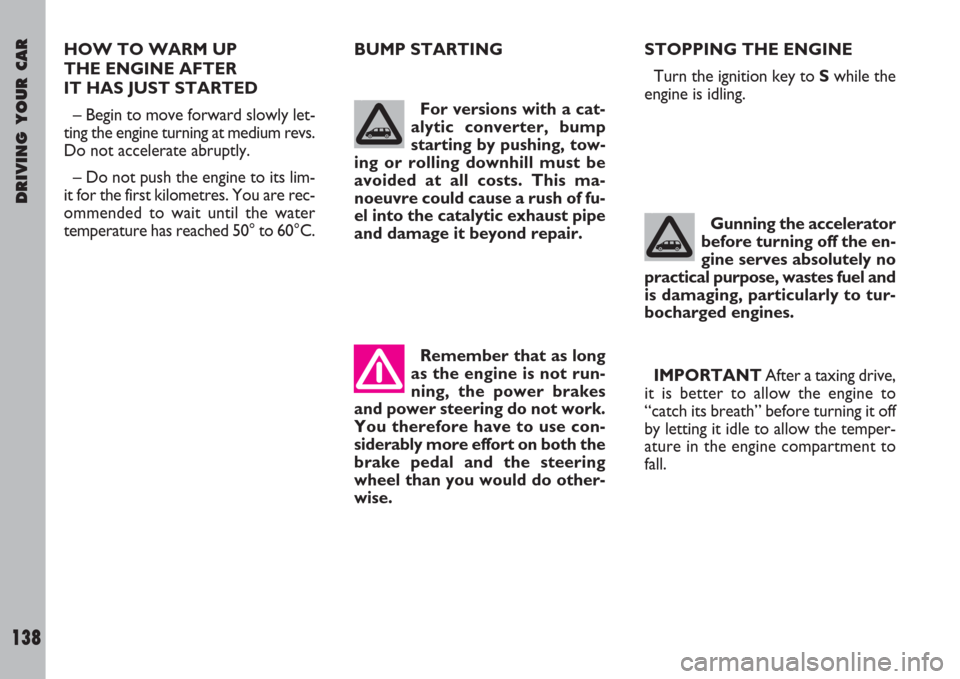
DRIVING YOUR CAR
138
HOW TO WARM UP
THE ENGINE AFTER
IT HAS JUST STARTED
– Begin to move forward slowly let-
ting the engine turning at medium revs.
Do not accelerate abruptly.
– Do not push the engine to its lim-
it for the first kilometres. You are rec-
ommended to wait until the water
temperature has reached 50° to 60°C.BUMP STARTING
For versions with a cat-
alytic converter, bump
starting by pushing, tow-
ing or rolling downhill must be
avoided at all costs. This ma-
noeuvre could cause a rush of fu-
el into the catalytic exhaust pipe
and damage it beyond repair.STOPPING THE ENGINE
Turn the ignition key to Swhile the
engine is idling.
Remember that as long
as the engine is not run-
ning, the power brakes
and power steering do not work.
You therefore have to use con-
siderably more effort on both the
brake pedal and the steering
wheel than you would do other-
wise.
Gunning the accelerator
before turning off the en-
gine serves absolutely no
practical purpose, wastes fuel and
is damaging, particularly to tur-
bocharged engines.
IMPORTANTAfter a taxing drive,
it is better to allow the engine to
“catch its breath” before turning it off
by letting it idle to allow the temper-
ature in the engine compartment to
fall.
Page 140 of 254
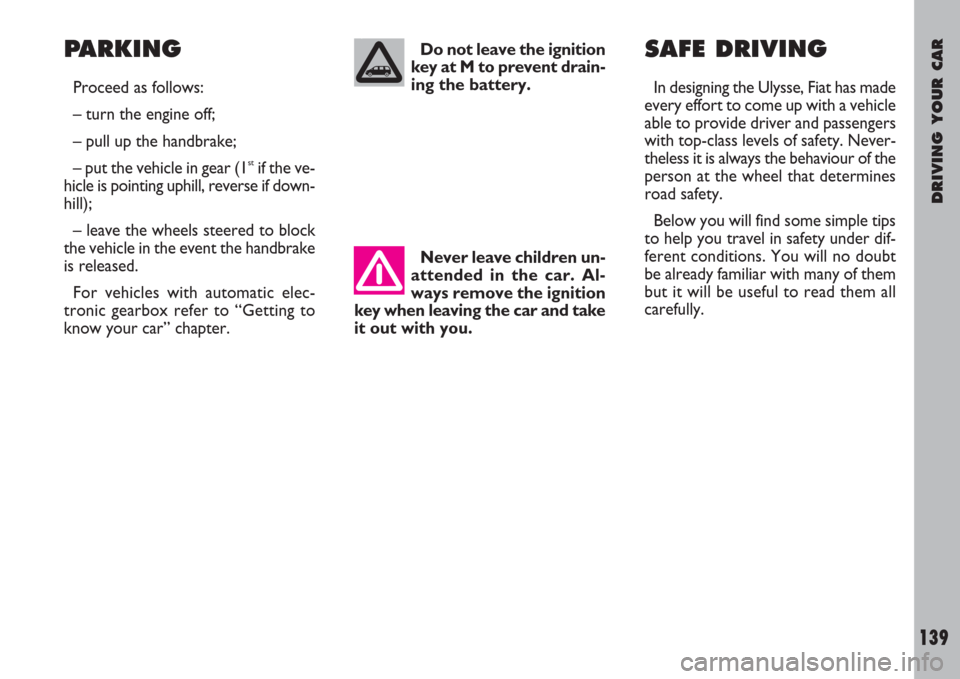
DRIVING YOUR CAR
139
PARKING
Proceed as follows:
– turn the engine off;
– pull up the handbrake;
– put the vehicle in gear (1
stif the ve-
hicle is pointing uphill, reverse if down-
hill);
– leave the wheels steered to block
the vehicle in the event the handbrake
is released.
For vehicles with automatic elec-
tronic gearbox refer to “Getting to
know your car” chapter.
SAFE DRIVING
In designing the Ulysse, Fiat has made
every effort to come up with a vehicle
able to provide driver and passengers
with top-class levels of safety. Never-
theless it is always the behaviour of the
person at the wheel that determines
road safety.
Below you will find some simple tips
to help you travel in safety under dif-
ferent conditions. You will no doubt
be already familiar with many of them
but it will be useful to read them all
carefully. Do not leave the ignition
key at M to prevent drain-
ing the battery.
Never leave children un-
attended in the car. Al-
ways remove the ignition
key when leaving the car and take
it out with you.